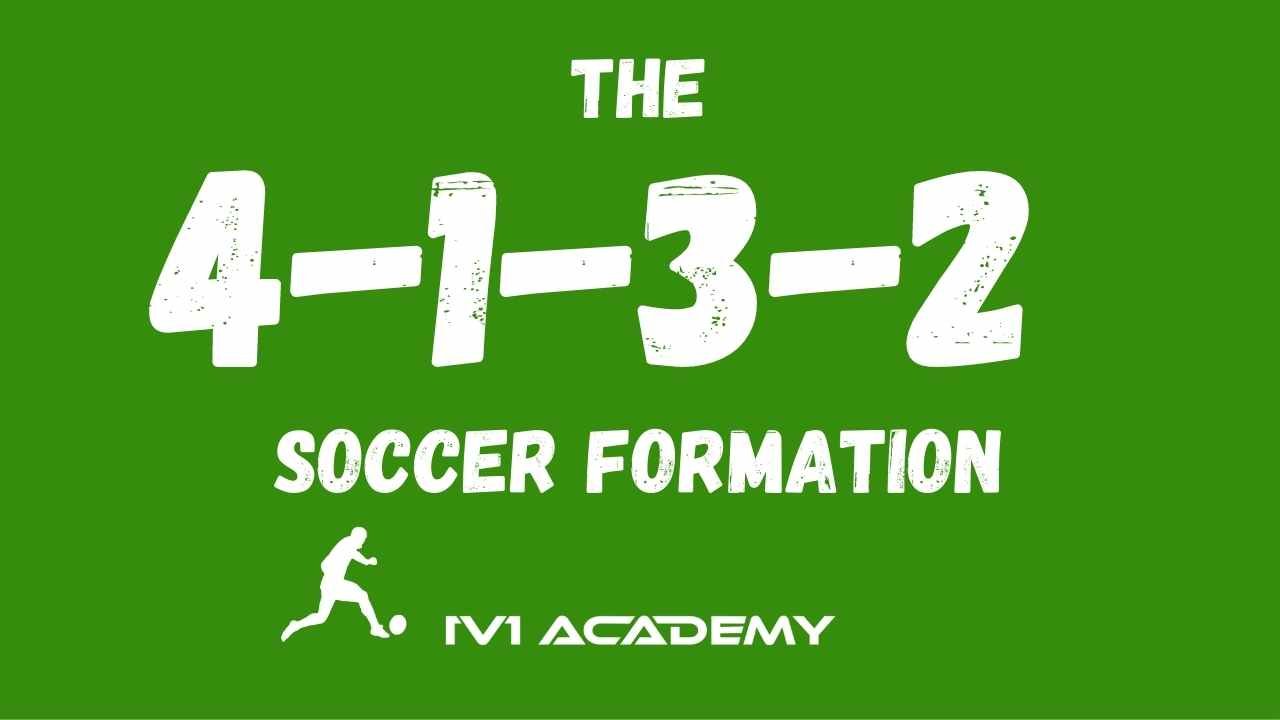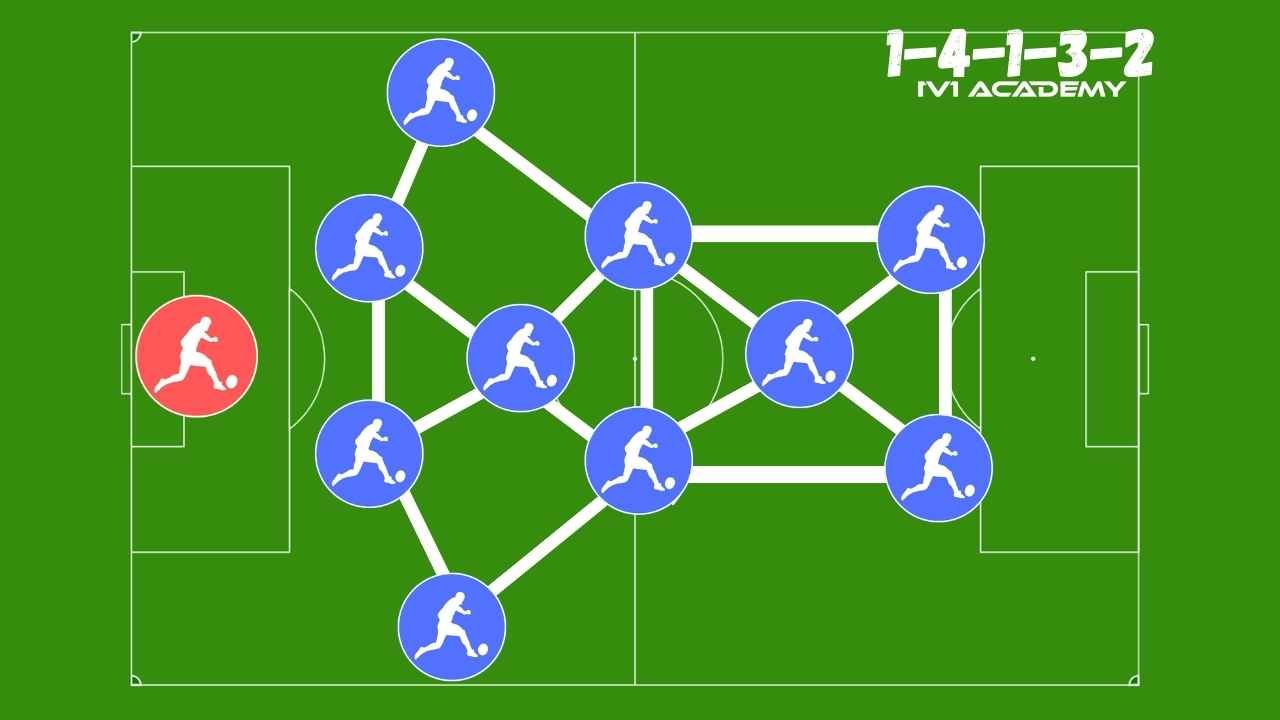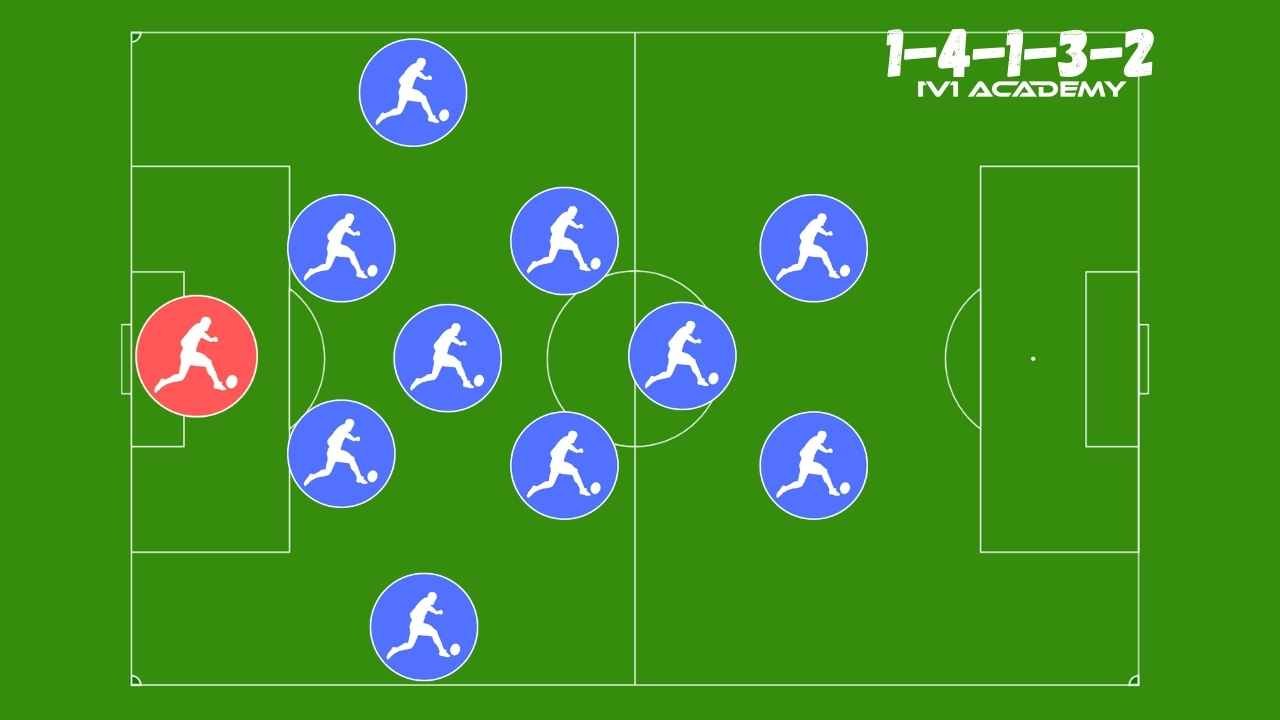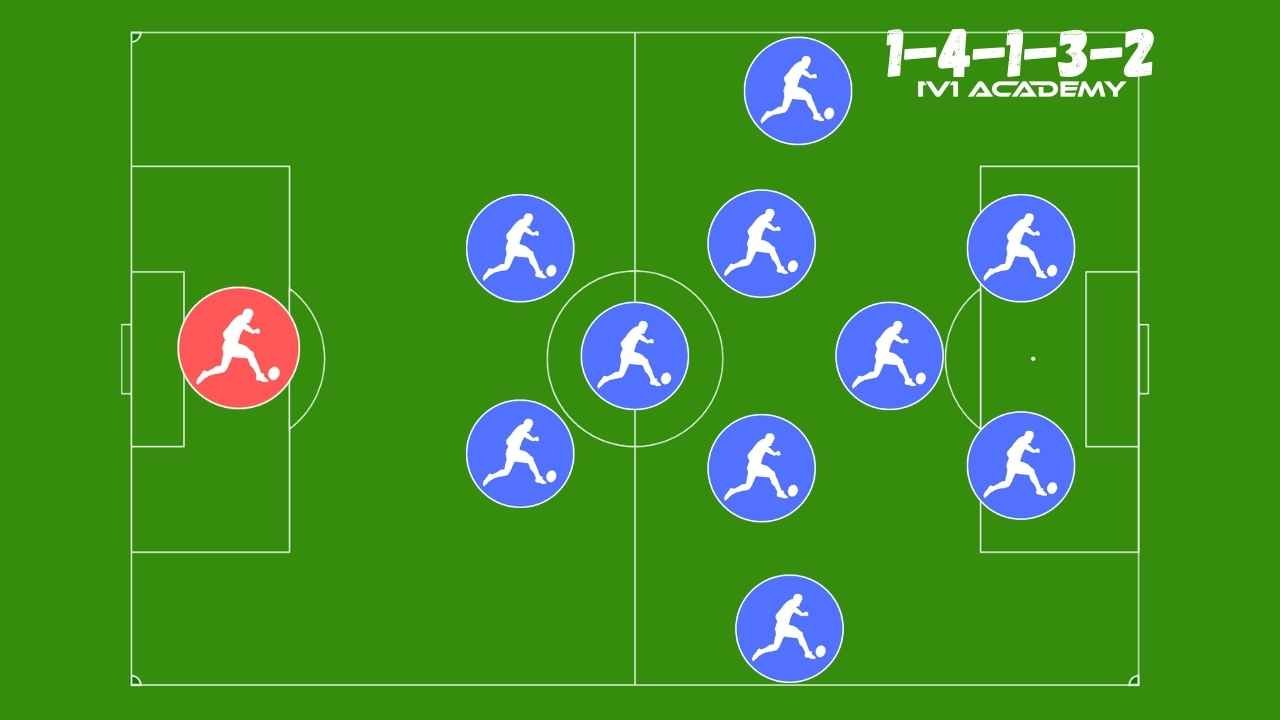
Play to listen to the article.
By Rudy Glez
1v1Academy. An Online Soccer Academy
Mastering the 4-1-3-2 Soccer Formation. Tactics, Strategies, and Training Tips
Discover the secrets behind the 1-4-1-3-2 soccer formation, a dynamic and versatile system of play that can revolutionize your team’s performance. Next, we’ll delve into how this formation works, how to implement it effectively, and strategies to maximize its potential. Get ready to unlock your team’s full potential on the pitch!
What is the 4-1-3-2 soccer formation?
The 4-1-3-2 formation is a strategic arrangement of players on the soccer field. It consists of one goalkeeper, four defenders, one holding midfielder, three midfielders, and two forwards. This system aims to strike a balance between defensive solidity and attacking prowess.
How does the 4-1-3-2 soccer formation work?
The backbone of the 4-1-3-2 formation lies in its solid defensive structure. Four defenders and a holding midfielder create a solid shield to protect your goal. Meanwhile, the three midfielders provide creative support, creating a diamond shape with the holding mid. The two forwards offer lethal attacking options.
Implementing the 4-1-3-2 soccer formation
To implement this formation effectively, start by assigning roles to each player based on their strengths. The goalkeeper must communicate and organize the defense. Defenders should be strong in one-on-one situations. The holding midfielder must be a relentless ball-winner and an efficient passer.
Strategies for the 4-1-3-2 soccer formation
With the 4-1-3-2 formation, you have various strategies at your disposal. Use the width of the field by instructing your fullbacks to overlap the midfielders. Encourage the holding midfielder to screen the defense and launch counterattacks quickly.
Adjusting the 4-1-3-2 soccer formation
Remember, the beauty of this formation lies in its adaptability. Tailor the 4-1-3-2 to your team’s strengths and weaknesses. Experiment with player positions and roles to maximize their potential. Stay flexible and be open to modifications as you observe your team’s progress.
The 4-1-3-2 soccer formation is a powerful weapon in the arsenal of any coach. By understanding its intricacies, implementing it effectively, and employing suitable strategies, you can transform your team into a formidable force on the field. So gather your players, train them diligently, and watch as they unleash their full potential using this dynamic system of play. Get ready to revolutionize your team’s soccer development and achieve greatness!

RECOMMENDATIONS FOR THE 4-1-3-2 SOCCER FORMATION
- Exploit Defensive Stability: The 4-1-3-2 formation provides a solid defensive structure with four defenders and a holding midfielder. This creates a robust shield to protect your goal and frustrate opposing attackers.
- Enhance Creative Midfield Presence: With three midfielders and a holding mid, the 4-1-3-2 system can create a strong midfield. These players should possess excellent passing, vision, and dribbling skills to dictate the tempo and create scoring opportunities.
- Utilize Dual Striking Threats: Having two forwards in the 4-1-3-2 formation provides a potent attacking force. Ensure your forwards are versatile, combining strength, speed, and clinical finishing to keep opposing defenders on their toes.
- Foster Strong Communication: Effective communication between players is essential to utilize the 4-1-3-2 formation. Encourage constant dialogue among the defenders, holding midfielder, and midfielders to maintain shape, coordinate defensive efforts, and launch swift counterattacks.
- Encourage Overlapping Runs: Exploit the width of the pitch by instructing your fullbacks to overlap the midfielders. This strategic move adds an extra attacking dimension, overwhelming opposing defenses and creating opportunities for crosses and cutbacks.
- Emphasize Quick Transition Play: With the 4-1-3-2 formation, swift transitions from defense to attack are crucial. Train your team to quickly transition from a solid defensive position to a fast-paced counterattack, catching opponents off guard and capitalizing on their defensive vulnerabilities.
- Embrace Flexibility and Adaptability: Remember, no formation is set in stone. Adjust the 4-1-3-2 system to suit your team’s unique strengths and weaknesses. Experiment with player positions, roles, and movements to maximize their capabilities and exploit the opposition’s vulnerabilities.
- Continuous Player Development: Regularly assess your players’ skills and capabilities to ensure they are suitable for the 4-1-3-2 formation. Tailor training sessions to enhance individual strengths and address weaknesses, empowering them to excel within the system.
- Analyze and Modify: Monitor your team’s performance closely and analyze their success and challenges within the 4-1-3-2 formation. Be open to making modifications based on your observations, refining the system to fit your team’s dynamics, and optimizing their overall performance.
- Instill Confidence and Teamwork: Building confidence and fostering strong teamwork is paramount in any formation. Encourage your players to trust each other, communicate effectively, and work collectively towards a shared goal. A united team will thrive in the 4-1-3-2 system.
By embracing the 4-1-3-2 soccer formation and tailoring it to your team’s capabilities, you can unlock its superiority over other systems. Develop your players’ skills, emphasize communication and teamwork, and watch as your squad unleashes its full potential on the field. Get ready to dominate the game and achieve soccer greatness with this dynamic and versatile tactical approach!

WHEN TO UTILIZE THE 4-1-3-2 SOCCER FORMATION.
Recommendations for Using the 4-1-3-2 Soccer Formation
- Capitalize on Offensive Strengths: Deploy the 4-1-3-2 formation when your team boasts skillful and versatile forwards who can consistently threaten the opponent’s goal.
- Leverage Midfield Creativity: Utilize the 4-1-3-2 system when your midfielders possess exceptional passing, dribbling, and playmaking abilities, enabling them to control the game’s tempo.
- Strengthen Defensive Resilience: Implement the 4-1-3-2 formation if you have four solid defenders who excel in one-on-one situations and exhibit strong communication and defensive discipline.
- Exploit Wide Attacking Options: Choose the 4-1-3-2 formation when your team has fullbacks with excellent crossing and overlapping abilities, providing width and creating scoring opportunities.
- Emphasize Quick Transition Play: Opt for the 4-1-3-2 system if your team thrives on rapid counterattacks, as the formation’s structure facilitates swift transitions from defense to attack.
- Benefit from a Dominant Holding Midfielder: Utilize the 4-1-3-2 formation when you possess a holding midfielder who breaks up opposition attacks, shields the defense, and distributes the ball efficiently.
- Embrace Tactical Versatility: Implement the 4-1-3-2 system if players can adapt to multiple positions and fulfill various roles, allowing flexibility and effective in-game adjustments.
- Exploit Opposition Weaknesses: Choose the 4-1-3-2 formation based on analyzing your opponent’s vulnerabilities and identifying areas where the system’s structure can exploit their defensive or midfield weaknesses.
- Leverage Individual Player Capabilities: Deploy the 4-1-3-2 formation when your team has players who align with the positions and responsibilities required by the system, maximizing their strengths and potential impact.
- Instill Confidence and Practice: Use the 4-1-3-2 formation once your team has practiced and internalized the necessary movements, player roles, and tactical strategies through consistent training and match simulations.
By carefully assessing your team’s player capabilities, strengths, and the specific context of each match, you can determine the ideal timing to implement the 4-1-3-2 soccer formation. Remember, successfully utilizing this dynamic system relies on understanding your team’s unique attributes and adapting the formation to optimize performance. Unleash the power of the 4-1-3-2 system when the conditions align for victory on the field!

WHEN TO AVOID THE 4-1-3-2 SOCCER FORMATION.
Recommendations for Avoiding the 4-1-3-2 Soccer Formation
- Limited Defensive Depth: Avoid the 4-1-3-2 formation if your team lacks quality defenders or has inexperienced players in defensive positions.
- Insufficient Midfield Control: Stay away from the 4-1-3-2 system if your midfielders lack the necessary passing accuracy, creativity, or work rate to dominate the middle of the pitch.
- Lack of Forward Depth: Avoid the 4-1-3-2 formation if your team doesn’t possess enough quality forwards to execute the attacking responsibilities effectively.
- Defensive Vulnerabilities on the Flanks: Steer clear of the 4-1-3-2 system when your team has fullbacks who struggle with defensive positioning or lack the speed to cover wide areas.
- Limited Holding Midfielder Options: Avoid the 4-1-3-2 formation if your team lacks a player capable of effectively fulfilling the holding midfielder role, disrupting opposition attacks, and providing defensive stability.
- Rigidity and Lack of Adaptability: Steer clear of the 4-1-3-2 system if your players are uncomfortable with positional interchangeability or struggle to adapt to different roles within the formation.
- Opponent Exploitation: Avoid the 4-1-3-2 formation when facing opponents with superior midfield control or utilize wide attacking play to exploit defensive weaknesses.
- Inadequate Player Familiarity: Steer clear of the 4-1-3-2 system if your team has not had sufficient training time to understand the movement patterns, positional responsibilities, and tactical strategies associated with the formation.
- Imbalanced Player Skill Set: Avoid the 4-1-3-2 formation if your team’s players predominantly possess skills and attributes better suited to other formations or systems of play.
- Lack of Confidence and Team Unity: Steer clear of the 4-1-3-2 system if your team lacks the confidence, communication, and teamwork required to execute the formation effectively.
By considering your team’s player capabilities, weaknesses, and the specific context of each match, you can decide whether to avoid implementing the 4-1-3-2 soccer formation. Remember, player, fit, and suitability are critical factors in determining the optimal system of play for your team’s success. Choose the formation that best aligns with your players’ strengths to maximize their potential on the field.
Conclusion:
In conclusion, the 4-1-3-2 soccer formation offers exciting opportunities for teams to excel on the field. With its attacking potential, midfield control, and defensive stability, it’s worth exploring further to elevate your game. To better understand this formation and maximize its effectiveness, check out the educational resources at 1v1 Academy.
At 1v1 Academy, we’re passionate about soccer education and empowering players and coaches to reach new heights. Our comprehensive resources cover tactical insights, training techniques, and player development strategies designed to enhance your understanding of the game.
Join our community by following 1v1 Academy on social media, where we share valuable tips, engaging content, and updates. By staying connected, you’ll be part of a vibrant network of soccer enthusiasts, ready to learn and grow together.
Don’t hesitate. Act now and take this opportunity to broaden your knowledge and enhance your skills. Unleash your potential and elevate your game to new levels. Start your journey today and become the player or coach you aspire to be!
Remember, the pursuit of knowledge never stops. With 1v1 Academy, you’ll always be one step ahead in your soccer journey.
Explore more positions like the 3-5-2 system on play.
1v1Academy. Online Soccer Academy
